Peyote
| The peyote (Lophophora williamasii) is a small spineless cactus that lives in the deserts of Mexico and Texas. It contains approximately 44 alkaloids, about 30% is mescaline a potent psychoactive chemical. |
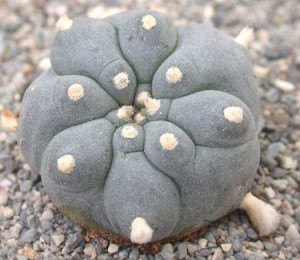 Peyote Cactus
(Lophophora williamsonii) |
People of the Peyote
| The peyote has been a central figure in the spiritual and medicinal system of a number of peoples including the Huichol of Mexico. The Huichol are a unique group of First Peoples who evaded Spanish conquest by retreating into the mountains of the Sierra Madre. Every year a long pilgramage (up to 300 miles for some) in search of the peyote from the place of their ancestors. |
 The Mountains of Sierra Madre |
| The Huichol people are scattered in small villages throughout this mountainous region. |
 A Huichol Village |
| The structure to the right is well-suited for the hot summers. Beneath offers shelt to livestock while the enclosure above is used for crop storage (maize) or sleeping. The heat of summer alternates with the bitter frigidity of the winter months. |
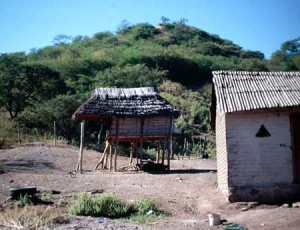 Structures in a Huichol Village |
| Before visiting the village we were relieved of evil by the shaman in a short ceremnony. |
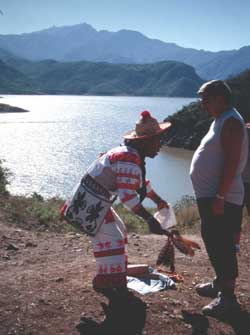 Shaman |
| Few visitors are permitted to visit the village. The influences of the outside world are not always welcome. Arrows have taken on ceremonial roles. The feather arrow in the hand of the Shaman is used to draw the evil from the visitor and then cast it away. |
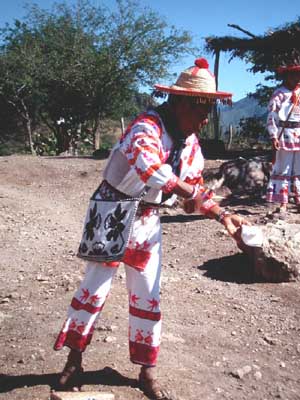 Shaman casting evil spirits away |
| It is not only the Shaman who wears brightly coloured close. The Huichol people are known for their intricate embroidry. Three prominant figures appear as motifs on their clothes: the peyote, maize, and deer. Santos, in the picture below, is an artist and guide. |
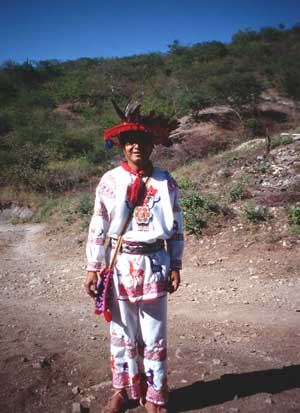 Santos |
| The peyote was and continues to be the centre of religious rituals and cultural symbolism. The three main figures are the peyote, the maize, and the deer. All three are of the same essence. Peyote and Maize sprang from the body of ancestor deity Brother Deer. Maize and deer are nourishment for the body. Peyote is the food for the soul (divine being and messenger). |
 The peyote is represented in the centre of
this bowl with the corn and deer around the edges. |
| Their artwork is unitque and bright. The yarn painting in Figure below is one such works that has been inspire by the peyote. This yarn painting was done by Jose Benito Sanchez. Bee’s wax is applied to a piece of wood and the yarn pressed over the surface to make the intricate design. The brightness and number of colours is the result of European contact.with fine cotton fibres. Prior to the arrival of Europeans wool would have been used. On the back of such artwork you will often find an explanation to the piece. The writing on the back of this piece was translated from Spanish/Huichol. It reads” The Cauymarie – In life Nierica is recognized to be the peyote that is consumed to become a part of the collective memory of our ancestors. This peyote consumed during the ceremony is necessary to get n touch with cauyemarie, the deer horned shaman and be able to understand his language.” On the quest for the peyote one of the objectives is to get in touch with the spirits of the ancestors by consuming peyote. This is done in a highly regimented way to ensure that the body is receptive. |
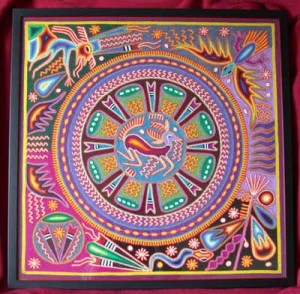 Yarn Painting by Jose Benito Sanchez. |
| Here, you can get a closer look at the peyote. |
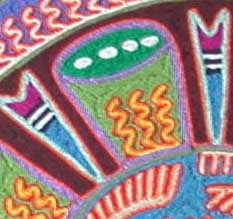 Representation of a Peyote from
the Yarn Painting of Jose Benito Sanchez. |
| Round figures in yarn paintings symbiolize prayer bowls. |
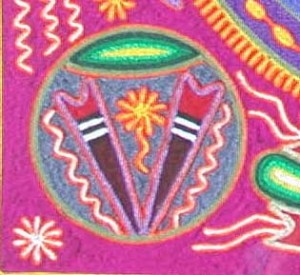 Represntation of a Prayer Bowl from
the Yarn Painting of Jose Benito Sanchez. |
| Prayer bowls are used not only in commerce, but also ………..The inner wall of the gourd is lined with bee’s wax and the beads are attached one-by-one. The appearance of the prayer bowls have also been influenced. Glass beads substitute the rocks, feathers. |
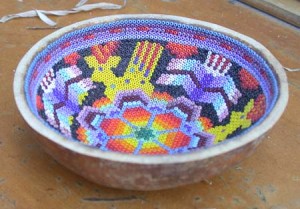 Huichol Prayer Bowl |
| Wooden carvings are often used as a substrate for this art. In Figure below is a wooden carving of a deer. |
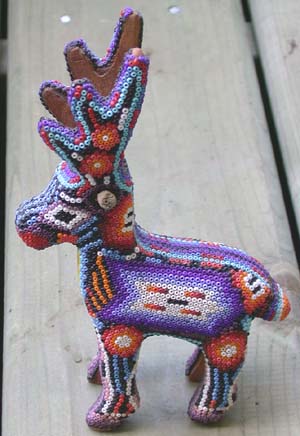 Carving of a Deer Adorned with Beads |
Items such as yarn paintings, bead works and other forms of art are sold at market. For many it is the only form of income. These are also sold in larger towns and cities.
Back to Lab 7.













